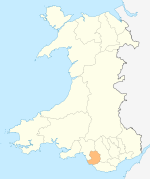- Kenfig
-
Kenfig (Welsh: Cynffig) is a village and former borough in Bridgend, Wales. The borough contributed with other Glamorgan towns to sending a member of parliament to Westminster until the Reform Act of 1832. The municipal ceremonial mace is in the National Museum of Wales but a pewter copy is on view in a public house.
The area was originally settled in the Bronze Age, while the later mediæval town is now covered by the Kenfig Burrows sand dunes. The current village is a continuation of the mediæval one, built further inland. Other attractions include the ruins of Kenfig Castle and a natural pool popular with birdwatchers. This is one of the few places in Britain where the bittern can be seen during the winter.
The area of sand dunes and the pool are a National Nature Reserve, and the area is designated as a Site of Special Scientific Interest. There is a visitor and interpretation centre next to a car park. The dunes are home to a wide variety of rare and endangered species of plants and animals, including an exceptionally high concentration of fen orchid (or Liparis Loeselii). It makes up part of the largest active sand dune system in Europe.
Kenfig is an area that is renowned in local legend and folklore, not to mention a novel, The Maid of Sker, by R. D. Blackmore, Inspired by a combination of local legend and Sker House itself. The Bronze Age settlement was originally situated around Kenfig Castle, but the encroaching sand became too much for the inhabitants in around the 13th century CE, at which time they relocated the village further inland, thereby forming the current village of Kenfig and Marlas. The church was moved from the original village stone by stone and currently stands in the village of Pyle, where the relocation is evident in the unusual fact that the smaller stones are at the bottom of the church, while the larger ones are at the top. All that remains now of Kenfig Castle is covered by the sand dunes, except for the top of its 50-foot keep, which was uncovered in the early 20th century.
Contents
Industrial history
In 1968 BorgWarner opened a plant at Kenfig for the manufacture of automatic transmissions.[1] In January 1976 the plant celebrated the completion of its two millionth gearbox, which was 'presented' to A B Volvo.[1] At that time a press release stated that Borg-Warner's UK plants at Letchworth and at Kenfig were producing transmissions for use in more than fifty different car models, and that more than half the gearboxes produced were exported outside the UK.[1] In 2001, the factory faced the threat of closure but was saved by a new contract from Korean car company Kia. In December 2008, Borg-Warner announced that the plant would finally close by mid 2010 with the loss of all 110 jobs at the site; a statement from the company blamed the economic downturn for the decision.[2]
Kenfig Hill
Sources and further reading
- ^ a b c "News: Two million Borg-Warner boxes". Autocar. 144 (nbr 4133): page 43. date 24 January 1976.
- ^ BBC NEWS | Wales | South West Wales | 110 jobs to go as car plant shuts
External links
- Kenfig.org.uk
- Kenfig Society
- The history of the medieval town, its charter and governances, and its destruction by sand
- Bro Cynffig Chronicles, the story of Cynffig told by its children.
- Castle Wales pages
- BBC nature reserve page, including video footage.
- Glamorgan Walks suggested tour
- www.geograph.co.uk : photos of Kenfig and surrounding area
Coordinates: 51°30′55″N 3°43′38″W / 51.5153°N 3.7272°W
Bridgend County Borough Communities Brackla · Bridgend · Cefn Cribwr · Coity · Coychurch Higher · Coychurch Lower · Cornelly · Garw Valley · Laleston · Llangynwyd Lower · Llangynwyd Middle · Maesteg · Merthyr Mawr · Newcastle Higher · Ogmore Vale · Pencoed · Porthcawl · Pyle · St Bride's Minor · Ynysawdre
Towns and villages Aberkenfig · Bettws · Blackmill · Bridgend · Bryncethin · Brynmenyn · Bryntirion · Caerau · Cefn Cross · Cornelly · Coychurch · Cwmfelin · Danygraig · Garth · Heol-y-Cyw · Kenfig · Kenfig Hill · Litchard · Llangan · Llangeinor · Llangwynydd · Llangynwyd · Maudlam · Maesteg · Merthyr Mawr · Nantymoel · Newton · North Cornelly · Nottage · Pantygog · Pantyrawel · Pen-y-Fai · Pencoed · Pontycymer · Porthcawl · Price Town · Pyle · Sarn · South Cornelly · Tondu · Tythegston · Wild Mill · WyndhamCastles Rivers Categories:- Villages in Bridgend county borough
- M4 corridor
- Former populated places in Wales
Wikimedia Foundation. 2010.


